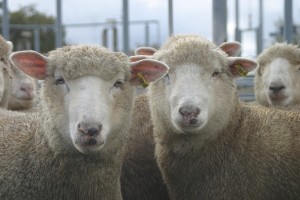
Lambs with electronic EID or RFID tags.
VICTORIA’S electronic sheep and goat identification transition package grants have generated an estimated $2.4 million investment in new equipment and software by the state’s producers.
Agriculture Victoria this week said the $750,000 in producer grants provided were now fully subscribed, but all sheep and goat producers would continue to benefit from the tag subsidies funded through the transition package.
More than 480 producers received a grant, driving around $2.4 million investment in the industry, Agriculture Victoria said.
Click here to get the latest Sheep Central story links sent to your email inbox.
The producer grants for the purchase of optional equipment were part of the Labor Government’s $17 million package to support the industry’s transition to the new mandatory electronic identification system for sheep and goats.
Agriculture Victoria’s director of sheep electronic identification Warren Straw said there were no plans to extend further grants to assist more producers.
Minister for Agriculture Jaala Pulford said the producer grants were a key part of our transition package.
“It has been great to see how it’s helped many producers to move a bit more quickly and explore how they can squeeze the most out of the EID opportunity.
“Electronic ID will help protect Victoria’s sheep and goat industries and our access to important export markets,” she said.
“This is game-changing technology and Victorian farmers are proudly leading the way.”
Farm manager for The Falls Pastoral at Euroa, Jake Hill, said the operation received $3000 to cover part of its purchase of tag readers, weighing equipment and digital displays.
“The grant has helped to move us along more quickly – it’s been perfect timing.”
The property has been primarily focused on its cattle operation, but Jake has identified an opportunity to diversify the business into sheep meat production. Ag4iculture Victoria said the EID equipment will mean that Falls Pastoral can measure and track the individual animals in its flock and understand how the various inputs they invest in translate into additional grams of weight and ultimately a better return on investment.
Hamilton district prime lamb producer Tony Fleetwood used grant fund to co-fund the purchase of weigh bars, an indicator and a panel reader. He runs a prime lamb operation directly supplying a large retail chain that sells his lamb products at a premium price.
Tony has been using electronic ID for close to 15 years, but the upgrade to his operation will allow him to gather additional data to make better decisions on his stocking rate and the number of lambs weaned per hectare. Closely tracking individual animals will enable better decisions of which animals to offload in a drought, Agriculture Victoria said.
“To me, farming is a business – it’s all about planning and monitoring.”
“There has to be a reason for what we as farmers do, and why,” he said.
“This grant is helping me to move toward the future I imagined over 30 years ago when I left ag college.”
Tony noted that one of the biggest early achievements from the Labor Government’s reform has been rapidly shifting the number of electronic tags from hundreds of thousands, to many millions.
It now creates an economy of scale for software and hardware companies to develop products that fully leverage the opportunity of electronic ID and data integration to drive flock performance, Agriculture Victoria said.
Source: Agriculture Victoria.

A further comment: if “producer grants were a key part of the transition package”, how can it be that only $750,000 out of the $17 million package (4.4 percent) was allocated to this component and it is now “fully subscribed”? In 2012-2013, there were 10,716 farms in Victoria that recorded some form of sheep production on their properties (ABS data), yet only about 480 (4.5pc) received a grant. Hardly conducive to squeezing the most out of the EID opportunity.
A lot of producers have missed out on funding to assist with purchase of the equipment necessary to make the compulsory electronic tags actually work. Clearly, funding for this aspect of the scheme was grossly inadequate because what was advertised as a scheme for producers lasting for 12 months has been declared “fully subscribed” in just six months. It is hard to justify only partial support by government for a scheme which has been imposed on everyone with sheep. In the interests of getting maximum compliance, rather than the strong possibility of sub-optimal compliance and consequent long-term problems, funding should be extended until the end of the year of implementation — 2017.